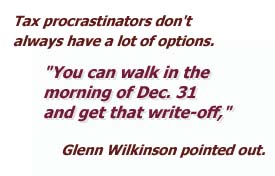|
Drilling for Uncle Sam
|
 |
October 9, 1999: 10:48 a.m. ET
Investors in natural gas and oil partnerships can offset tax liabilities
By Staff Writer Alex Frew McMillan
|
NEW YORK (CNNfn) - Getting a big bonus? Just won the lottery? Flat out got more money than you know what to do with? Some financial planners tell clients in those enviable positions to consider offsetting the big tax burden they're facing with an investment in oil or gas partnerships.
Such partnerships get a special exemption from the Internal Revenue Service. The tax break was originally designed to encourage investment in the risky, highly speculative business of searching for energy when resources were running short.
So how does it work?
The companies can write off up to 80 percent of their costs for the "intangible drilling cost" of drilling wells. Those costs include money spent on exploration, hiring contractors, paperwork and so on. By splitting ownership of the wells with investors, the companies can allocate the intangible costs to the partnerships and the investors, while the company pays for most or all of the tangible costs, such as drilling machinery and pipelines.

So a company such as Bridgeport, W. Va.-based Petroleum Development Corp., which drills for gas in four states, structures its partnerships so investors can deduct as much as 89.5 percent of their investment on their taxes. Other companies have been more aggressive, and partnerships with as much as a 100 percent tax deduction aren't unheard of.
And the deduction comes in the year you put the money into the partnership. So if you've got a big tax burden for 1999, you'll have up to the end of the calendar year invest.
"You can walk in the morning of Dec. 31 and get that write-off," said Glenn Wilkinson, a registered investment advisor who runs Wilkinson Financial Group in Fayetteville, N.C. and sells the programs. Because it's one of the few tax-abatement schemes like that, he often ends up pointing procrastinators in that direction. "You get an immediate tax deduction … and you get a stream of cash payments starting after six months."
There have been problems in the past
Oil and gas partnerships were all the rage during the energy crisis of the late '70s, and many went belly up when oil prices collapsed and the industry crashed in the mid-'80s. The Tax Reform Act of 1986 also made the partnerships much less attractive, and by 1987 many of the companies offering them were out of business. Some investors lost large amounts of money, particularly in oil investments in Texas, giving energy-industry partnerships a serious black eye.
But several reputable companies still offer partnerships that generate a big tax benefit. Alex Montano, managing director of Irvine, Calif.-based C.K. Cooper & Co.'s oil and gas group, analyzes the industry. He said it's important to invest in a company with a long track record and it's vital that it's a public company.
Besides Petroleum Development Corp. (PETD), Philadelphia-based Resource America Inc. (REXI)'s Atlas Group, Twinsburg, Ohio-based North Coast Energy Inc. (NCEB) and San Diego-based Royale Energy Inc. (ROYL) are legitimate and decently run, he said. Houston-based Swift Energy Co. (SFY) last year stopped offering the partnerships when the company got too big. Critics point out a bad gas market also meant they weren't doing too well at the time.

"There's a level of information that's available for companies that are public," Montano said. "It takes out the risk of who you're dealing with." Companies such as PDC register their public partnerships with the Securities and Exchange Commission, and analysts scour their books.
Montano and others recommend avoiding the many, often small companies offering private, unregistered limited partnerships, which may be fly-by-night. They're also likely to have smaller programs with fewer wells, increasing the risk of duds.
This is for the rich, or that sudden bonus
The tax write-off isn't really worthwhile for people who are below the 31 percent income tax bracket, most financial planners say. But at 31 percent, an investor putting $10,000 into one of the partnerships and deducting $8,950 on their taxes is saving $2,775 in income tax.
People in higher tax brackets obviously save more. The top federal tax bracket is 39.6 percent, and the deduction applies both to federal and the state taxes on top of that. In a high tax state such as California, investors can save close to half the money they put in the partnership in taxes.
Of course you have to have the money, and not need it for a while. Investors also need to make sure they don't take so large a write-off that the Alternative Minimum Tax kicks in, which would negate the benefits.
"This investment is generally recommended for higher-income tax brackets," said Marc Freedman, a financial planner with Freedman Financial Associates in Peabody, Mass. They earn enough to make the tax deduction worthwhile, and like all investments, there's risk involved with the rate of return, and they can withstand it.

Because the initial investment is spent on drilling, there's no principal to be returned when the partnership dissolves. After the wells are drilled, though, the investor does start to get monthly checks generated by selling the gas or oil to utilities. The returns are unpredictable, depending on the price of gas or oil, the quality of the wells, the efficiency of the company running them. There's also a depletion benefit that means some of each monthly check is tax free. That varies but is now around 17 percent.
It takes a long time to get back your money
Petroleum Development Corp. has posted returns from 5 percent to 30 percent in the first year after drilling, according to President Steve Williams. The company spreads the risk of a well being dry or poor quality - each partnership includes 25 to 105 wells, depending on the amount of money invested - and by drilling in parts of the country where it has found gas before.
The wells it drills in the Appalachian basin, in West Virginia and Pennsylvania, are typically long-lived, providing gas for 25 to 30 years, Williams said. In Colorado and Michigan, the other spots it drills in, the wells last less time, perhaps 15 to 20 years. That means its 14,000 or so investors in 51 partnerships should eventually get their money back, and the best partnerships generate sizable returns.
The partnerships worth looking at mainly invest in gas because that's more reliable to generate returns than oil drilling, which is notoriously unpredictable. Investing in energy is like investing in real estate, and PDC's programs aim for steady returns.
"When the hard times come, you don't make as much money, when the good times come you make quite a bit," PDC CEO Jim Ryan said. His company isn't into wildcatting for oil, he said. "It's not like we're going to go out and hit a home run. We're going to hit a lot of singles," he said.
The tax savings is the main motivation
The tax write-off is the primary advantage, analyst Montano said. For instance, PDC has returned, on average, only around 37 cents of each dollar of principal for partnerships set up in 1986 or later. That number may be a bit low because it includes one that hasn't drilled gas yet and partnerships that haven't concluded.
Eventually they'll likely get 100 percent of the money they put in back, he said. But some investment advisors look at any profit on the principal rather than taxes as "found money."
Montano praised PDC for its tax-management plan. "If you're looking for a cookie cutter, no-brainer on your taxes, PDC is a nice product," he said. "From a corporate standpoint, they're very fundamentally sound," and consistent. San Diego-based Royale typically has better cash returns, he said.
Though the tax write-off may not be as good, it would be more suited for people looking for a long-term gas investment. Royale had one plan it drilled in 1997 that has already returned 93 percent of investors' money, but that's very lucky, Montano said. The wells out West tend to produce faster but have shorter lives, he said. In most schemes the first few years show the best returns.
Morrie Reiff, a financial planner with Planned Asset Management in Encino, Calif., said he recommends that his clients take the tax deduction savings and invest them in a mutual fund or similar vehicle. That way, they gain from the write-off, the gas checks and possible future profits, a typically higher rate of return from the stock market and have a more-diversified portfolio. The partnerships he sells, offered by a private company, pay about 8 percent of the original investment back to investors each year.
There are risks involved. To get the initial tax write-off, investors have to be liable for the risks of drilling as "additional general partners." That means they're subject to lawsuits if there's an accident. PDC take out $50 million in insurance and says its largest claim has been $78,000. After drilling stops, the companies convert the investors to limited partners.
Because any returns are spread out over 20 to 30 years, the investments may not be suited for old people, though they can set up estate plans to pass the money on to their kids. You also have to be judged a suitable investor. That requirement varies from state to state, the minimum being $60,000 in income and $60,000 net worth. Some states require investors in the program to have net worths of half a million dollars or more.

|
|
|
|
|
 |

|

